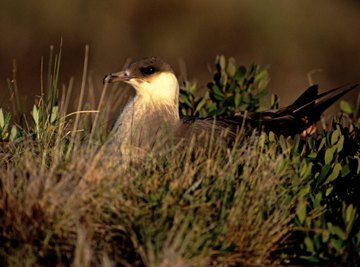
Several types of grass grow on the tundra, a word meaning treeless plain. Arctic tundra starts at the North Pole and continues south until the taiga forests begin. Alpine tundra is found on the tops of mountains. Both types of tundra rely on a variety of plant life, including grasses, that provide habitat, food resources and nesting areas for the region’s wildlife and birds.
Polar Grass (Arctagrostis latifolia)
Polar grass grows from sea level to 5,500 feet in elevation with two subspecies growing in different parts of the world. One subspecies, A. latifolia subsp. arundinacea, grows in the low arctic areas of Alaska and northern Canada. The other larger species, subsp. latifolia, grows in the high Arctic. The grass grows from five to 60 inches in height with grizzly bears and reindeer grazing on the highly nutritious grass thanks to its valuable protein. Other smaller wildlife and birds also rely on the grass for food and cover.
Ice Grass (Phippsia algida)
Ice grass grows at high elevations in the Rocky Mountains and the Andes Mountains in South America as well as in arctic regions in Greenland. The grass is one of the first grasses to flower in the high arctic. The grass grows very quickly in disturbed areas, such as those caused by glacial withdrawal, slides or disturbance by wildlife. Ice grass grows in a wide range of soil types, including alkaline and peat soil. It also grows in muddy areas.
Vahl’s Alkali Grass (Puccinellia vahliana)
Vahl’s alkali grass sometimes grows with ice grass in high arctic regions in Alaska, northern Canada and Greenland. The grass grows in a variety of soils, including gravel, sand, clay and moss in moist areas. The grass is often one of the first to appear in moist clay and silt next to alpine streams, lakes, glacial runoff and on snow beds. The grass grows up to 4.5 inches in height, featuring flat or folded blades.
Cottongrass (Eriophorum callitrix)
The cottongrass plant looks just like it sounds, making this tundra grass easily identified. The short-bladed grass features small white to pale brown flowers that resemble balls of fluffy cotton. The seeds of cottongrass are disbursed by the wind. Migrating snow geese rely on cottongrass as an important food source, while caribou calves eat the plants to help them get ready for the migration to their wintering grounds. The Inuit make use of cottongrass by using the seed heads in place of wicks in their oil lamps.
References
Resources
About the Author
Nancy Wagner is a marketing strategist and speaker who started writing in 1998. She writes business plans for startups and established companies and teaches marketing and promotional tactics at local workshops. Wagner's business and marketing articles have appeared in "Home Business Journal," "Nation’s Business," "Emerging Business" and "The Mortgage Press," among others. She holds a B.S. from Eastern Illinois University.
Photo Credits
altrendo nature/Stockbyte/Getty Images
